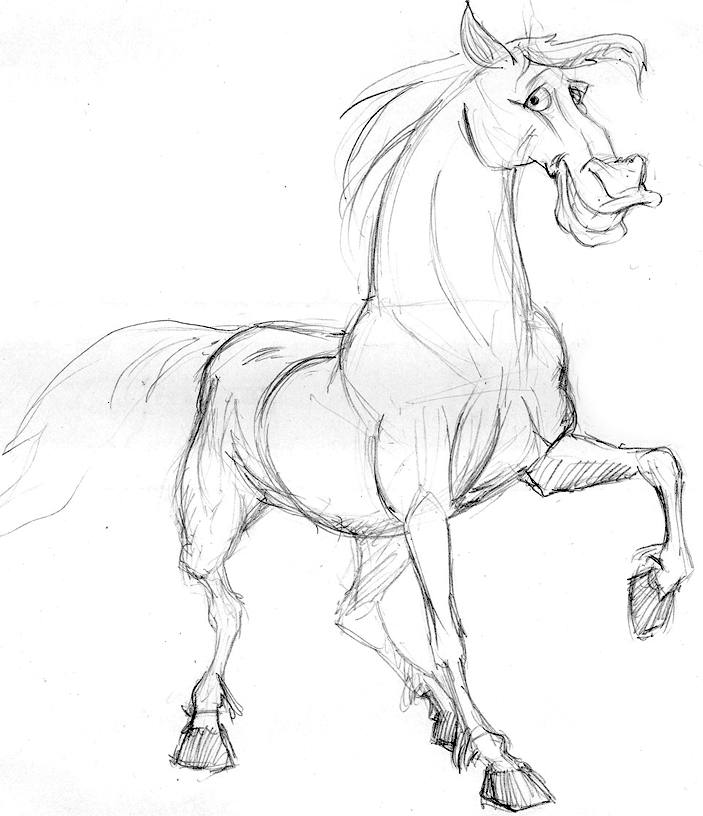The horse Buce
Dark horse, eat like a horse, don’t look a gift horse in the mouth –– these are just a few idioms with the word “horse”. The horse in our story is called Buce, short for Bucephalus. We’re still not sure which of the names came first, though.

Before we started, no one thought the horse could be such a complicated character, and that work on it could take so long.
Seemingly, there’s nothing difficult about it. Just draw a horse. Everyone has seen them more than once, not only in feature films and cartoons, but also in real life.
So, we drew it, but what we got was an ordinary, unremarkable horse… Still, we needed a movie Hero, a Character, not just an ordinary animal.

Our Buce was supposed to be not an ordinary burden horse or a peasant horse, but a horse that would look equally good on the battlefield and harnessed to Gojo’s cart. At the same time, he had to be unique. For this purpose, we invited animalist painters, and they had a better one.
After a long and unsuccessful search for a look, we realized that our superficial attitude to the task wouldn’t do. We needed a deeper understanding of the nature, habits and movements of real horses.
The producer approved and we went to the countryside to see the horses ourselves.

There we learned a lot about horses (they really laughed at us like horses), talked to breeders and trainers (they also laughed), rode horses (laughing at each other) …


After this trip everything ran smoothly – Buce came to life, acquired charm and character. However, see for yourself…

Now it’s time to revive him, to give him the opportunity to move, to breathe deeply.

It all starts with modeling the horse. The artist draws views of the front and sides, details the problem areas, and passes the finished sketches to the modeler. Gradually a new character appears, not only on paper but also in 3D.
Now he can be seen from all sides, not just from the one that the artist drew. And now the model is ready, but this is only a small part of the job. Now we have to make a skeleton and control element, i.e. rig. The next step is “skinning”, that is, the resulting system (rig) should be tied to the finished model, and animate our horse.

A particular trait was the long neck, which took us a long time to get smooth movements of all the vertebrae (especially in the lower part of the neck). Now our horse can do whatever: run, jump, or even sneak. He can also climb a tree, if the director asks for it.

The Gipsy cart
The Gypsy cart is one of the important characters in our cartoon, so it was given special attention.

It should reflect in the cartoon one of the most important aspects of any person’s life – his family. Here is everything: kids, the beloved wife and parents, and hard-earned property.

Here is the fourth version of the cart after packing all the household stuff inside. Everything went in, including the grandad.

Then a 3-D model and animation followed along the same lines.


To make the animation realistic, we had to add “shock absorbers” to the wheels, add cloth simulation, and run it down a hill!
Done! The cart is ready for filming.
Let’s hitch the horse!

We’re done with everything needed for the animation phase, all that’s left is hitch Buce to the cart. At that moment we realized that we had missed such an important detail as the harness. We had to go back to the artists and they designed a not too fancy but quite realistic harness.
With the 3D model of the harness in hand, the animators puzzled over how to attach it to the horse, because all the straps repeat the movements of the horse, but, at the same time, they are separate objects.

It was necessary to make them not only move almost synchronously with the horse’s skin, but also slide and shift to the movement. For this we had to use the tissue dynamics described earlier.

Finally, everything is ready for animation. To start with, it was decided to do just one step. Stepping is the slowest type of horse movement. When stepping, the horse leans on each of the four legs in sequence, pushes off with the right hind leg, then comes the front right leg, then the left hind leg and then the front left leg, followed by the right hind leg and so on.
For a realistic imitation of the horse’s gait a lot of materials were studied: both drawings and videos from the Internet and filmed by us at the hippodrome.

And now our Buce stepped and pulled the cart. The first animation for the cartoon was done, and it reflected the interaction between the characters and objects.
In the next posts we will tell you how Bucephalus’s facial expressions will be made, and how he will get a real mane and tail.






